GAZETTE ACE – September/October 2024
Enjoy the latest edition of the Gazette ACE, a digital flipbook that showcases the best of John Knox Village’s Arts, Culture, and Entertainment!
Enjoy the latest edition of the Gazette ACE, a digital flipbook that showcases the best of John Knox Village’s Arts, Culture, and Entertainment!
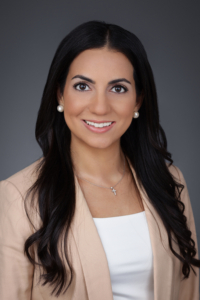 By Lucette Talamas, MS, RD, LDN
By Lucette Talamas, MS, RD, LDN
While some people face the heat only in the summer, Floridians are exposed to heat year-round with an extra high dose during the summer months.
Keeping hydrated is vital for our health. Staying properly hydrated can be challenging, especially for older adults. Thirst sensation is like a defense mechanism for the body to replenish water. However, the thirst sensation is often reduced in older adults. Therefore, it is not advisable to wait to drink water until one feels thirsty. Rather, aim to start your day with some water and continue throughout the day.
Dehydration is the loss of two percent of body weight due to fluid loss. For someone who weighs 150 pounds, that’s about three pounds. Dehydration symptoms include feeling very thirsty, dry mouth, urinating and sweating less than usual, dark-colored urine, dry skin, fatigue and dizziness. Dehydration can cause health issues and is a leading risk factor of urinary tract infections, which can also lead to other complications.
Dehydration is preventable. The best and most practical indicator of hydration is your urine color. Aim to maintain a pale-yellow color throughout the day.
Water is the primary choice for hydration. You may be wondering: How much water do I need? Individual water needs vary based on factors such as health conditions, heat and humidity, sweat loss through physical activity and illness such as fever, diarrhea or vomiting. About 19 percent of water intake comes from food. The Institute of Medicine recommends the following for adequate intake:
Men: 3.7 liters (16 cups) of total water per day, or 3 liters (13 cups) from only water and beverages.
Women (not pregnant or breastfeeding): 2.7 liters (12 cups) of total water per day, or 2.2 liters (9 ½ cups) from only water and beverages.
Foods contribute to water intake, especially fruits, veggies and soups. The fruits and vegetables that have the highest water content are cantaloupe, strawberries, watermelon, cucumber, lettuce, cabbage, celery, spinach, cooked squash, carrots, broccoli, grapes, oranges, pears and pineapple.
Besides water, other beverages that are hydrating can include low-fat milk, unsweetened milk alternatives, herbal teas and low-sodium soups. Sports drinks are intended to be consumed after engaging in strenuous physical activity that lasts at least an hour.
They can also be used to replenish fluids lost from vomiting or diarrhea. People with diabetes should use caution when drinking sports drinks, outside of these circumstances, as they do have added sugars. It is best to limit sugar-sweetened beverages like soda and avoid energy drinks.
Some Tips For Staying Hydrated:
• Never leave home without a refillable, insulated water bottle.
• Prepare a glass of water the night before in your bedroom to drink when awakening the next day.
• Aim for two servings of fruit per day and at least three servings of vegetables – especially the hydrating ones.
• Entice your senses to drink water by changing the temperature – ice water or room temperature – it’s up to you.
• Add a natural flavor enhancer like lemon or lime juice or cucumber slice.
• Coffee can contribute to fluid intake as long as it does not exceed 400 mg of caffeine (about four cups of coffee) per day.
Sources:
https://www.ncbi.nlm.nih.gov/pmc/articles/PMC6629391/
https://medlineplus.gov/dehydration.html
https://nap.nationalacademies.org/download/10925#
Lucette Talamas, MS, RD, LDN, is a Registered Dietitian for Community Health at Baptist Health South Florida. Ms. Talamas holds a Bachelor’s Degree in Food Science and Human Nutrition from the University of Florida and a Master of Science in Nutrition and Wellness from Benedictine University. She also earned CDR Certificate of Training in Obesity for Adults and Pediatrics.
About John Knox Village
John Knox Village, set on a scenic 70-acre campus, is South Florida’s leading Continuing Care Retirement Community, celebrating 57 years of excellence.
JKV offers a comprehensive approach to retirement with a continuum of care including independent living, assisted living, memory care, and skilled nursing. Our elegant residences, vibrant community, and extensive amenities—including an Aquatic Complex, diverse dining options, fitness centers, and cultural activities—ensure comfort and promote enrichment.
Our caring team is committed to providing personalized support in a life plan community, delivering peace of mind for residents and their families.
Interested in learning more about John Knox Village? Contact us today for a no-pressure conversation with a Life Plan Consultant, or to schedule a visit.
Jason Cook
Technology Engagement Coordinator, John Knox Village
We are three months into the “season.”
Unfortunately, I am not talking about the season of gifts, although many of the items I’m writing about are actually great gifts. The season I am referring to is hurricane season.
According to the National Oceanic and Atmospheric Administration (NOAA), which is a good place to get information on hurricanes, the season runs from June 1 until November 30. As a tech person who had to go five days without electricity during one of our previous storms, I was traumatized and decided to get some gadgets and make plans to be sure, if this were to happen again, I would be prepared.
Solar Power Bank
The first thing I got was a solar power bank. This device ranges in price from $20 to $200, depending on the size of the battery and other features. This power bank will allow you to charge your phone a few times before the bank needs to be recharged. Since it has solar panels, you are able to charge it during the day even when there is no electricity.
Rechargeable Fan with a USB Plug
The second item I put in my hurricane kit was a rechargeable fan with a USB plug so it would fit in the power bank. This means when I went to bed at night, I would plug in the fan to the power bank and it would have enough power to keep me cool all night between the battery in the fan and the power bank.
Rechargeable AM/FM Radio
The final gadget I added to my kit was a rechargeable AM/FM radio. After the hurricane there is a pretty good chance that there won’t be any internet or cell phone service for a few days. Having the radio will allow you to hear the news and get information you might need.
If you noticed, all of these options do not require regular batteries. This allows you to avoid panic-buying that often occurs when a hurricane is approaching.
Download Some Entertainment
The final piece of advice I would offer to keep yourself entertained would be to download some games, music and movies to your mobile device so that you have something to do even without a signal. If you download these items and store them on your device, you will have access to them even if there is no cell or internet service.
Preparing for storm season by including a few simple tech devices as part of your hurricane kit, you can rest easier knowing you’ll be able to stay as comfortable as possible, and most importantly, stay connected.
JKV’s ‘IT’ Guy
Always an industry leader and at the forefront of innovation, John Knox Village is one of the only senior living Life-Plan Continuing Care Retirement Communities in the nation to provide a dedicated full-time employee to assist its residents with technology issues on every platform from mobile phones and tablets to laptops.
JKV Technology Engagement Coordinator Jason Cook provides residents with personal assistance, as well as classroom-style training. Overwhelmingly, the residents are thrilled and grateful to have Jason on the JKV Team and see the value in the important work he does.
Contact us today to learn more about John Knox Village or to schedule a visit.
Terry Colli moved to JKV with his partner, Jerry Oshinski, in December 2016 and he says that it was one of the best decisions of their lives. Jerry and Terry loved it here, but unfortunately, it was to be short-lived. Jerry passed away in August 2018 after 40 happy years together. As a retired official from a high-level government job as the head of public affairs for the Canadian Embassy in Washington, D.C., Terry remained actively involved in his new JKV community. In 2019 he was recommended by the JKV Resident Senate to become a Resident Board Member, where he still serves today. JKV is shining the Pride Month Spotlight on Terry Colli and his impressive career.
JKV: Where are you from, Terry?
TC: I grew up in a small town (pop. 2,800) on the Canadian prairies. At university, I was attracted to economics, and, after graduating with a B.A., I went on to do a Master’s Degree in economics at the University of British Columbia. Economics was going to be my career when I got a job teaching that subject at the University of Saskatchewan. But two years later the trajectory changed when I got a call to join the Canadian Department of External Affairs in Ottawa.
JKV: Tell us about you and your early career.
TC: A lot of my career can best be explained as serendipitous because I thought I had a plan – but life got in the way. My progress in the Canadian Foreign Service was routine – until I received a posting to Washington, D.C. Once there, I met the man who would be the love of my life – Jerry. But to make this relationship work, I had to find a way to get out of the traditional Foreign Service assignment rotation. With good luck, I discovered that the powers that be were looking to create a permanent position in the Embassy that would do a deep dive into the workings of the U.S. economy. YES!!
A couple of years later, “the fickle finger of fate” was again at work. The Ambassador of the day was without an executive assistant, and suddenly, it was me. Then, the fates really got down to business.
JKV: What do you mean?
TC: It happened that a very important visit to Washington by the Canadian Prime Minister was planned. Suddenly, I was the leader of the Embassy team, preparing all the technical details for the visit. I got the job because more senior players in the Embassy thought I was suitable cannon fodder if things went wrong! But they did not go wrong, and when the smoke cleared, the Ambassador promoted me to the head of Public Affairs – a role I filled at increasing levels of responsibility for the remainder of my career.
JKV: Can you tell us about a career highlight?
TC: A top highlight for me was the “Spirit of Haida Gwaii” project. This was a massive sculpture on the folkways and culture of the Haida Gwaii nation of the Queen Charlotte Islands that was to be placed at the entrance of the Canadian Embassy. The sponsor was RJR Nabisco. A handshake with the artist, Bill Reid, set the deal in motion. But over the course of the next three years the cost escalated from $300,000 to $3 million, and the hand-shaker from the corporation was long gone. Pulling the project back from the brink of disaster took some fancy footwork and calling in lots of favors. But it got done – and we celebrated the installation with 60 members of the Haida nation present to bless the sculpture and ensure its happy life.

Spirit of Haida Gwaii, the Black Canoe, by Bill Reid, outside the Canadian Embassy in Washington, D.C.
JKV: What drew you to John Knox Village?
TC: As my career was ending, Jerry and I decided that South Florida would be a good place to retire. He had already retired a few years earlier and was spending much of the winter here. Unfortunately, soon after, Jerry’s health was starting to deteriorate, and our large house was more than I could manage by myself. After some exploration, our focus turned to John Knox Village, and at the end of 2016, we officially moved here.
JKV: What have you enjoyed as a Resident Board Member?
TC: It has been a very active four and a half years. I am proud to have served through the construction of the Pavilion and Westlake, which are major financial investments. The greatest achievement has been overcoming operating deficits and getting to a stable footing where our operating revenues are covering expenses. I am pleased to say that JKV’s future looks bright!
About John Knox Village (JKV)
For the past 50+ years, JKV has set the bar when it comes to delivering an all-inclusive resort lifestyle designed for living life to the fullest at each stage of retirement. JKV emphasizes fitness and overall well-being with world-class programming, state-of-the-art amenities, healthy and delicious dining, and much more. Residents are entitled to unlimited use of healthcare services and 24/7 healthcare professionals on campus. There are no time or financial limits on the long-term care benefits that residents receive, regardless of the level of care required. Simply put, a life plan contract at JKV provides a fiscal safety net with an unparalleled community geared to a wide range of needs for living life to its fullest at every stage of retirement.
Want to learn more about what John Knox Village has to offer? Contact us today to take a tour, or for a no-pressure conversation with one of our Life Plan Consultants.
Surfside Ushered in a New Era for Condo Living
On June 24, 2021, the Champlain Towers in Surfside, Florida, tragically collapsed, killing 98 people and leaving hundreds more temporarily homeless. The upcoming third anniversary of this tragedy hits especially close to home, having occurred right here in our own South Florida community.
In the aftermath of this catastrophe, home insurance premiums have significantly increased, and condominium association fees have skyrocketed.
When the Florida Legislature passed Senate Bill 4-D in May 2022, it created new requirements for condominium and co-op buildings three or more stories tall. As a result of the Surfside collapse, the bill aims to improve building safety and maintenance standards with significant provisions related to roofing and building inspections with another new requirement: to reserve funds to pay for future long-term maintenance repair.
With these changes comes a hefty price tag. As home insurance prices steadily climb in the state with the threat of damaging storms and in the aftermath of Surfside, the steep rise in association fees has forced many people to relocate.
Homeowner’s Insurance Blues
While inflation cooled in 2023, prices for goods and services remain high, with no relief in sight. Last year, the Insurance Information Institute predicted that insurance in the Sunshine State could increase by 40%, and the average Florida homeowner is paying $6,000, more than triple the U.S. average of $1,700. Plus, insurance carriers are clamping down on renewals. As one example, Progressive Insurance announced that it plans to send out non-renewal notices to half of its insurance policies in December. This would impact an estimated 100,000 homeowners in Florida.
Florida Senate Bill 4-D – And What it Means for Condo Owners
Senate Bill 4-D requires condos higher than three stories to be inspected every 10 years once they hit the 30-year mark, and for those within three miles of the coast, this inspection is required for buildings 25 years and older. The first milestone inspection must be completed by December 31st of its 30th year.
There are 25,000 condo associations and 1.4 million individual condominiums in the state, and according to the CRC Group, a wholesale specialty insurance group, nearly 600,000 of these condos are over 40 years old. For older adults who have lived in their condos for years, the high expense of assessments and monthly fees can become unbearable, forcing them to move. Even older adults who are financially secure are fleeing their condominium homes.
Waiving Reserve Fund Contributions is a Thing of the Past
Another major change to Florida condo law will impact how associations handle reserved funds. Associations previously had the freedom to waive reserve contributions from their homeowners, but by December 31, 2024, they will no longer have that option. As a result, after January 1, 2025, all condo associations will be required to be on track to collect enough reserve funds to pay for replacement costs in the event they are needed, which is sure to translate to higher association fees for condo owners.
An Alternative To Skyrocketing Costs
With all the changes that condo associations are implementing as a result of changing regulations and the consequences that they bring to condominium owners, this may be the smartest time to sell. For seniors over the age of 62, moving to an active senior Continuing Care Retirement Community (CCRC), also known as a Life Plan Community, could be a very smart financial move toward protecting your assets.
“Often [outside] people don’t realize how much money JKV residents are saving,” Thom Price, vice president of Operations at JKV, told The Gazette. “Residents’ monthly service fees cover the equivalent of someone’s mortgage or rent. In addition, it pays for what would be association fees, property taxes, insurance, utilities, home maintenance, repairs and equipment replacement, lawn care, 24/7 security, on-site healthcare, while also providing a lifelong healthcare contract.”
A Life Plan Community is a senior living option that eliminates many costs that homeowners and condo owners are burdened with and instead, in addition to the benefits already stated, offers residents a set entry fee, with a stable monthly service fee that includes dining, lifelong learning opportunities, social and cultural arts events and housekeeping. It also offers some unique tax advantages. In short, it is an investment in yourself, rather than in a property’s association.
With all the changes that condo associations are implementing, and the financial consequences those changes are bringing to condo owners, Mr. Price affirms this may be the best time for seniors over the age of 62 to move to an active Life-Plan Community, such as John Knox Village.
“Frankly, this is the time to make a very strategic financial move for seniors to protect their assets, while enjoying their life’s next chapter in a Life-Plan community,” he said.
John Knox Village in Pompano Beach, Florida, is an internationally award-winning Life Plan Community boasting a lush, tropical 70-acre campus, resort-style amenities, a wellness-based lifestyle, and long-term healthcare should you ever need it. In many ways, JKV provides a safe haven from rising homeowner and condo costs and peace of mind for your future.
Want to learn more about what John Knox Village has to offer? Contact us today to schedule a tour, or for a no-pressure conversation with one of our Life Plan Consultants.
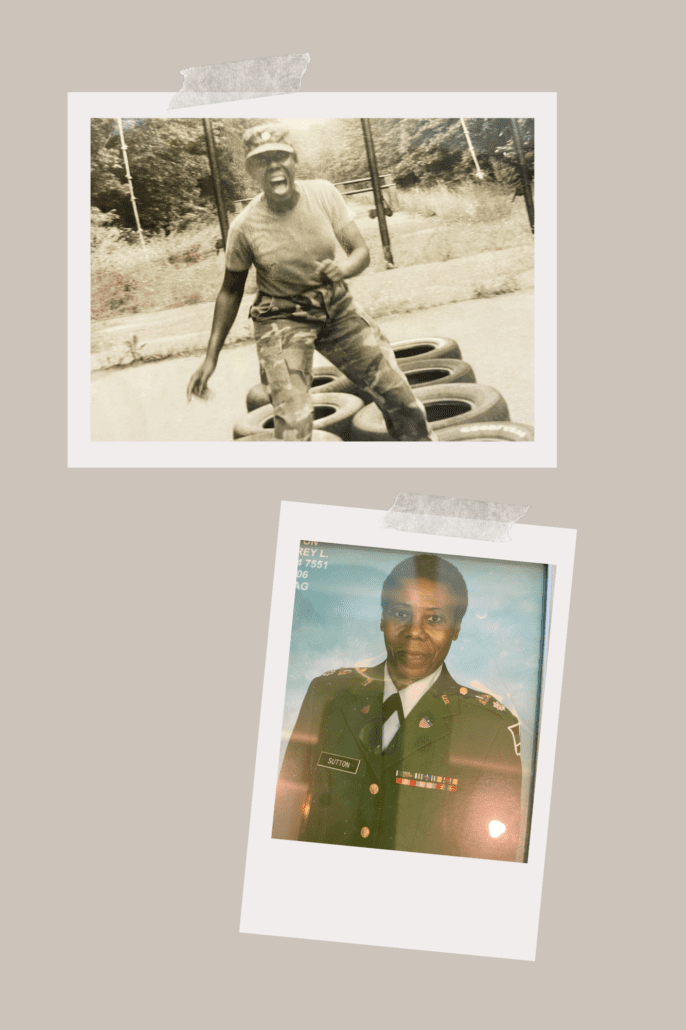
Audrey Sutton, Lieutenant Colonel, U.S. Army, Retired
Lakeside Villa Resident
In 1974, when JKV resident Audrey L. Sutton was the 26-year-old director of a community mental health center in Baltimore City, Maryland, she got an offer she couldn’t refuse. A Colonel whom she respected very highly dared her to try out to be in the Women’s Army Corps (WAC) Reserve. In order to recruit women, the Army’s basic training program had been reduced from eight weeks to two weeks, and with her MSW (Masters in Social Work) degree, Audrey was promised a Second Lieutenant rank upon graduation from basic training.
Always one to accept a positive challenge, Audrey enlisted almost immediately. Upon graduation from basic training at Fort Benning, Georgia, she was named “Honor Trainee of the Cycle.” Unfortunately, by the time she graduated, the program she had been enrolled in had been absolved, so instead of beginning her Army career as a Second Lieutenant, she began as a Private — the very bottom of the rank structure.
Audrey was extremely disappointed at this turn of events but decided to make the most of the situation and gave it her all, working very hard and meeting challenge after challenge. She spent some time as an enlisted soldier. During this time, her most memorable experience was when she scored 300 (the maximum score) on the physical training test. This was the first 300 score in the Battalion. The Battalion Commander was so impressed with this score that she submitted an article to the Washington Post recognizing the achievement.
After serving as an enlisted soldier for a period of time, her Battalion Commander enrolled Audrey in OCS (Officers’ Candidate School), a one-year training course. As a Reserve, she trained one weekend a month at the District of Columbia Armory. She graduated from OCS as a Second Lieutenant and received the first-ever Commandant’s Professional Award.
Audrey spent two years as a Second Lieutenant and received an early promotion to First Lieutenant. She was selected to become a company commander. Her primary duties and responsibilities included preparing the Company for an Inspector General Inspection, which the Company passed for the first time in three years. She also provided leadership and support to Company soldiers, especially during weekend training and challenging field exercises.
In 1983, she was promoted to Captain and was stationed at the Reserve Center in Baltimore City, Maryland. She was assigned another company command in Dover, Delaware. Up to this point, command positions in that battalion were always held by white males. Audrey was truly a trailblazer. For two and a half years as Commander, she traveled to the U.S. Army Reserve Center in Dover to serve one weekend a month.
After her command there, she received a promotion to Major and was stationed at Fort Belvoir, Virginia as a Military School Commandant and also served as Adjutant. Her duties included guiding and advising the overall Commander’s decisions regarding soldier welfare activities and concerns.
While serving as a Major, Audrey graduated from Equal Opportunity (EO) School in Cocoa Beach, Florida. As an Equal Employment Opportunity Officer, she taught classes of male and female soldiers about sexual harassment, what it was, that it would not be tolerated, and how to report any incidents that might occur.
After serving three years as School Commandant, she was promoted to Lieutenant Colonel and stationed at 80th Division in Richmond, Virgina. Her primary duty was that of Personnel Director, but she also performed other duties as assigned. She retired from the military in 2003.
During her military career, Audrey also held a number of full-time civilian positions, including Chief of Child Care for the City of Baltimore and Director of Child Welfare Services that oversaw Child Protective Services, Foster Care, Adoption and Family Services programs in Prince George’s County, Maryland and in Washington, D.C. After retirement from the military, she entered the private sector as the Chief Executive Officer of an adoption and foster care agency.
Audrey feels blessed to have had the support of her mom and her four siblings. Her mom told her, “Honey, aim high and never quit. Expect to win and stay tough. Remember, the difference between wishing and accomplishing is action.” These are words Audrey chose to live by throughout her 29-year military career—especially when she came out of Basic Training as a Private instead of the Second Lieutenant rank she had been promised.
When we asked Audrey if there was a person she served with that she remembers fondly, she immediately thought of her First Sergeant, Jean Branch, who she really admired. According to Audrey, “I was a First Lieutenant with no experience being a military leader.” Sergeant Branch assured her, “If you follow my lead, you’ll be fine.” Audrey did as Sergeant Branch suggested and they problem-solved together, which led to their becoming an outstanding Company with many commendations. Jean and Audrey became close friends, with a wonderful friendship that lasted through the ages.
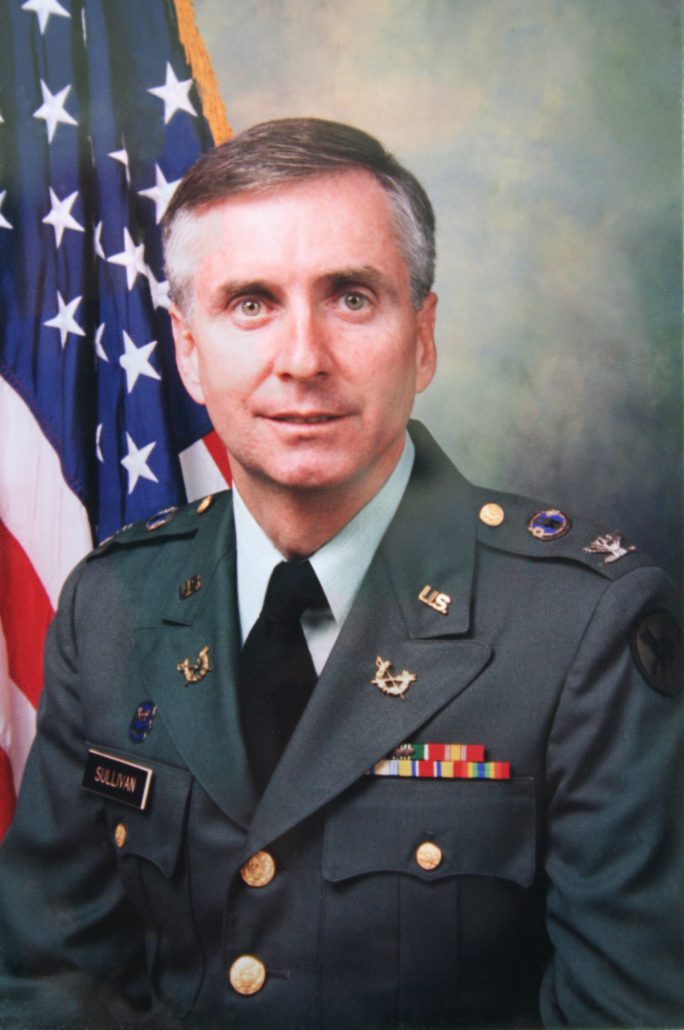
Bill Sullivan, U.S. Army Colonel, Retired
Westlake Resident
Bill was drafted in 1969 and reported for induction at the AFEES station in Jacksonville, Florida just as Neil Armstrong was taking man’s first step on the moon. From there, he was sent to Fort Dix, New Jersey, for basic training at a Private E-1. Bill graduated nine weeks later and received his officer’s commission as a Reserve Army Captain in the Judge Advocate General’s Corps. From Fort Dix, he was sent to Fort Lee, Virginia, for a two-week officer orientation course. Bill’s next assignment was to JAGC School at the University of Virginia for the two-month JAG Basic Course. The group graduated at Christmas in 1969 and received orders to report to their first duty station in January 1970 in Fort Riley, Kansas. Bill worked for a Colonel he respected, so when he was reassigned to Army Headquarters in Okinawa, which was then a Protectorate of the U.S., Bill requested to go with the Colonel. He received his reassignment to Okinawa a few months later. Bill and his wife Judy had their first child at Fort Riley, and when Judy arrived in Okinawa, she was ripe with baby number two, who was born a month later.
Bill’s most memorable assignment was as a member of the Army Homecoming Team, Operation Homecoming, Clark Air Base, Republic of the Philippines, from January 1973 to April 1973. Hostilities had just ended in Viet Nam and the POWs were being repatriated from their POW camps. Many were flown to Clark Air Force Base in the Philippines for debriefing, then to Germany, and then to the States. The Army had its team of doctors, social workers, chaplains, lawyers, and finance officers to deal with any questions or concerns that the men may have had. Bill vividly remembers standing on the tarmac at Clark as the Air Force transports landed and the men came down the boarding ramps. He states that there was not a dry eye in the house. That very scene was repeated many years later as the troops were coming home to Hunter Airfield in South Carolina after the first Gulf War as he stood on the tarmac at Hunter.
Okinawa was his terminal assignment, and after his discharge in 1974, he and Judy, with their two young daughters, moved to Lighthouse Point, Florida. Bill is from Miami, and Judy is from Coral Gables, so moving to South Florida was an easy decision. Bill started practicing law with his fraternity brother Peter Portley in 1974, and they continued to practice together until they both retired in 2020.
Bill’s active-duty career was from 1969 to 1974. He had the foresight to stay in the Active Reserves and retired as a Colonel in 1997. Bill concludes, “I always smile when someone thanks me for my service because I truly feel that I got more than I gave. Judy and I loved the culture of the military community, and we made so many great friends and shared so many wonderful experiences. There is a comradery of military service that is hard to explain unless you have experienced it. Judy and I both loved it, and we will always cherish the memories.”
As we celebrate Armed Forces Day around the nation, we would like to thank all members of the Armed Forces, past and present, for their dedication and service to our country. At John Knox Village, we treasure the many veterans who call JKV home. We’re honored to have them here.
We invite you to visit John Knox Village of Florida to learn more about us and see what sets us apart from other senior living communities. JKV is a life plan community offering an exceptional lifestyle and the financial security of having a plan in place for any future care that might arise.
To learn more, contact us for a conversation or to schedule a tour.
Moms make sure our beds are made, our teeth are brushed, and we eat our veggies – all things that set us up for a happy, healthy, successful life! But maybe most importantly, they dispense valuable advice that stands true throughout our lives.
We asked some of our residents and team members to share what their moms have taught them, and uncovered some gold nuggets:
“Mom used to say, ‘Think of the consequences before you step too far off your normal path, but don’t be afraid to open new doors and look inside.’” – Claire McCarty, JKV resident
“My mother-in-law used to say, ‘Don’t count your chickens with a hatchet.’ My grandmother used to say, ‘Smoking is not at all necessary and very unladylike.’” – Dorothy Romanelli, JKV resident
“My mom’s advice to me: ‘If you’re thinking about someone you haven’t been in contact with in a while, don’t wait to call, write or text. Make the time to reach out. Tomorrow is never promised,’ and ‘Give hugs and handshakes like you mean it!’” – Jody Puishys, JKV Executive Assistant
“My mom-in-law always says, ‘You can never do the wrong thing by doing the right thing.’ I love this. It has guided me to always try to take the high road.” – Yael Fishman, JKV Digital Marketing Coordinator
“My Aunt Mickey said, ‘NEVER pass up a chance to pee!’” – Diane Barton, JKV resident
“Don’t worry about anything until you know what you’re worrying about.” – Twylah Haun, JKV resident
“When you become a parent, you will always be a parent. But when your children become adults, you stop parenting.” – Jody Leshinsky, JKV Life Enrichment Manager
“As a young kid, I always wanted to take dance lessons. I was also pretty clumsy and I guess my mom knew that dance lessons were probably not something I’d ever benefit from. Her retort to me was always, ‘You’ve gotta get something in your head before you get it in your feet.’ Needless to say, I never got those dance lessons, but I did do well in school.” – Julie Vikmanis, JKV resident
“Love what you do and help others.” – Kellie Camp Thomas, JKV Community Engagement and Business Development Manager
“My mother always advised me that if you really want something to happen in your life that isn’t happening, write it down so it can be out in the universe to help manifest it. I have found that this tactic often works.” – Kim Morgan-Vagnuolo, JKV PR Specialist
“My mother taught me to say, ‘thank you.’ She said it was like a prayer and I must admit, I say it a lot. I’ve added a smile when saying it. I was taught it expresses gratitude, humility, and understanding. Try it and see what these two words from you do to others. Don’t forget to add a smile!” – Shari Vordermeier, JKV resident
And perhaps the best advice of all:
“Never cook bacon naked.” – Steph Messana, JKV resident
Click here for more “mom wisdom” from our residents!
Two recipes for a delicious Mother’s Day brunch!

Breakfast Tacos with Bacon, Avocado, and Sausage
Breakfast Tacos with Bacon, Avocado and Sausage
Serves 8
8 pieces bacon
8 breakfast sausages, cut into pieces
2 tablespoons extra virgin olive oil
8 large eggs
1 whole avocado, peeled, pitted, and small diced
8 soft taco tortillas, flour or corn
Salt & pepper to taste
Optional toppings:
Shredded cheddar cheese
Salsa
Chopped cilantro
Preheat oven to 375°. Place the bacon on a foil-lined baking sheet and bake until crispy, about 15-18 minutes. Drain on a paper towel and cut into small pieces.
Whisk the eggs in a bowl. Add 1 tablespoon of oil to a 10” pan and cook eggs over medium heat, using a spatula to move them while they cook, flipping a few times until they’re soft and pillowy but cooked through. Remove from pan, place in a bowl, and cover with foil to keep warm.
Add remaining olive oil to pan and cook sausage until cooked through, about 8 minutes. Remove from pan, place in a bowl, and cover with foil to keep warm.
Discard any remaining oil and wipe out pan with a clean paper towel. Warm each tortilla for about a minute on each side, flipping and removing to a plate. Keep stack of tortillas warm by covering plate with foil until it’s time to assemble the breakfast tacos.
Once all your components are ready, assemble by spooning sausage, eggs, bacon and avocado on to each tortilla and lining them up on a serving platter. Serve with shredded cheddar, salsa and chopped cilantro for topping.

Pink Grapefruit “Momosas”: Perfect for Mother’s Day
3 oz. red grapefruit juice, chilled
750 ml. Bottle of Prosecco or dry sparkling wine, chilled
Raspberries, pomegranate seeds or thyme for garnish
Fill stemware glasses or champagne flutes half full with grapefruit juice. Top off with Prosecco or sparkling wine and stir lightly.
Drop a few raspberries or pomegranate seeds into the glasses for extra garnish. Lay a small sprig of thyme across the top of the glass for an extra touch.

BV’s French Press Coffee & Wine Bar Grand Opening and Ribbon Cutting
On April 17, 2024, John Knox Village of Florida (JKV) in Pompano Beach proudly held its grand opening of BV’s French Press Coffee and Wine Bar, located on the lobby level of Westlake, its newest addition to the community. The new luxury apartment towers at JKV include 147 state-of-the-art apartment homes and many spaces on its ground floor where all residents and guests can gather, relax, and enjoy. Courtesy of a generous donation, BV’s was named in honor of its benefactor, JKV resident Bruce Voelkel, who has lived at JKV since 2017 and is an active member of the community.
The John Knox Village Foundation supports the community through innovative, compassionate programming and initiatives. According to the Foundation’s Executive Director Mark Dobosz, “Bruce’s donation to name BV’s French Press Coffee & Wine Bar is a perfect example of his commitment to the lifestyle, well-being, and pleasure for all Village residents to savor the delights of delicious coffee and wine.”
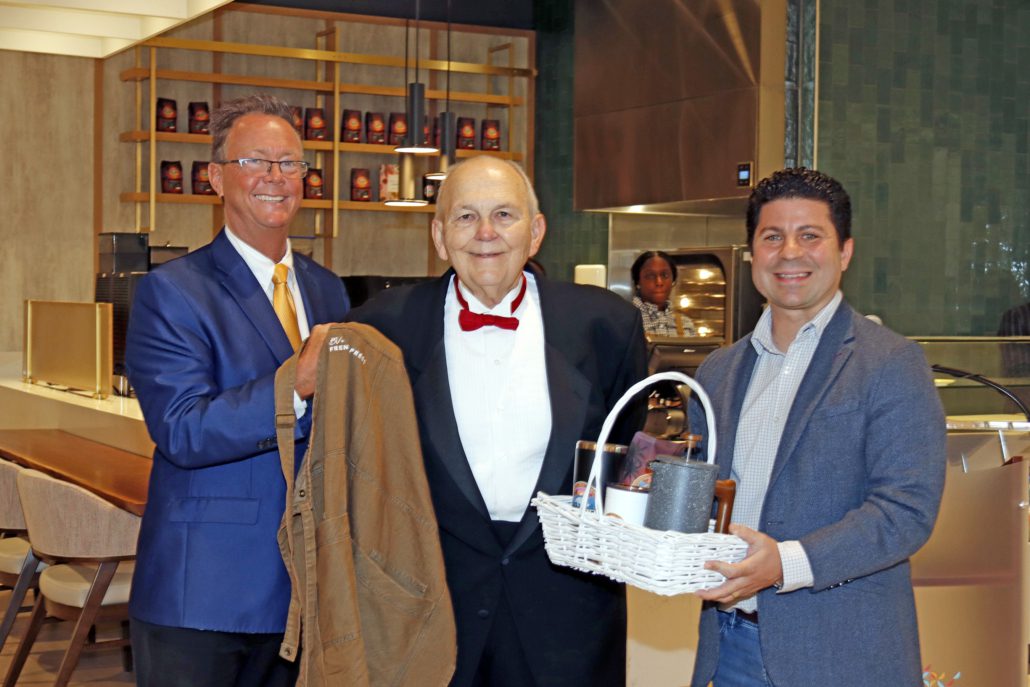
L-R: Lance Sanson, VP Dining, JKV Resident Bruce Voelkel, and Steve Turk, Founder Biscayne Coffee
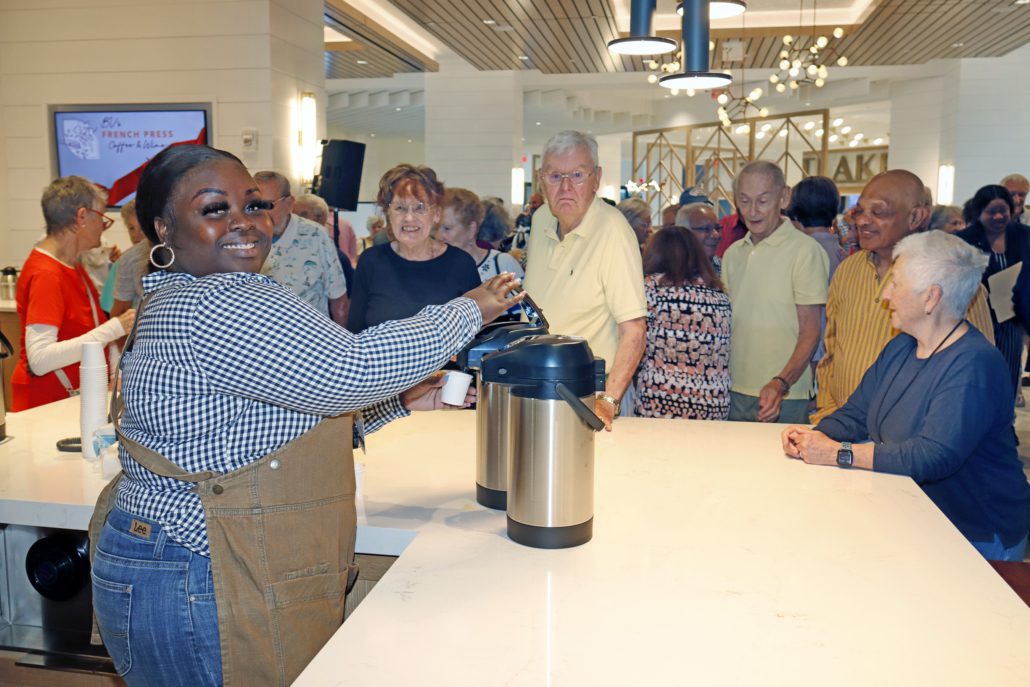
JKV’s Dining team member Shala McKenzie proudly serves BV’s first cups of coffee to what will sure to be many happy residents.
BV’s features offerings from Biscayne Coffee, a locally sourced coffee company that donates 10% of its proceeds to ocean conservation. Its founder, Steve Turk, participated in the ribbon cutting and presented Bruce with a gift basket and BV’s French Press apron.
Since 1967, JKV has been providing a fulfilling, engaging, and stress-free environment with an all-inclusive full continuum of care from independent living and assisted living to short and long-term skilled nursing care. As a Life Plan community, the internationally award-winning JKV allows proactive seniors to plan for their future healthcare needs while enjoying first-class amenities, life-long learning programs, and a full range of services that promote wellness of mind, body, and spirit. JKV continues to stay ahead of the curve by emphasizing fitness and overall well-being for each of its residents. Through unwavering commitment to excellence and guiding principles, the team brings the unique JKV experience to life every day for 1,000 residents.